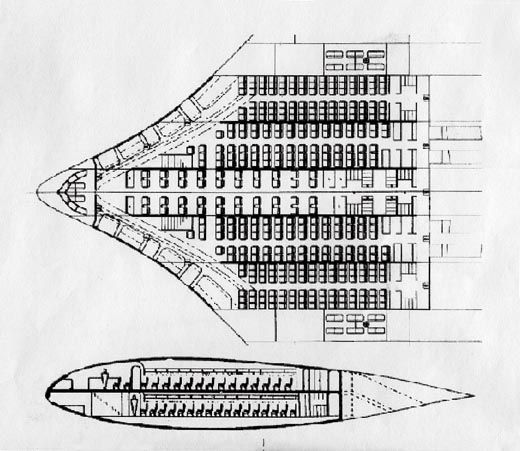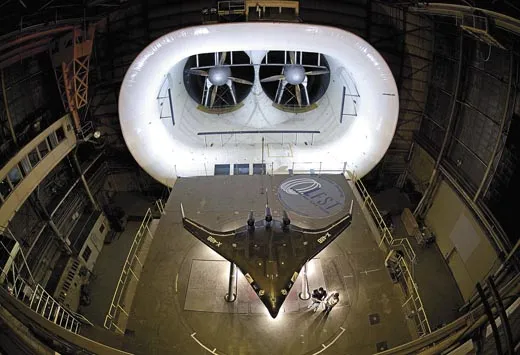Batplane
Even around other X-planes, the X-48B looks weird.
/https://tf-cmsv2-smithsonianmag-media.s3.amazonaws.com/filer/Future_BlendWing_Flash_SEP09.jpg)
Odd airplane shapes come and go, but the blended wing-body has staying power. First proposed in 1988 by McDonnell Douglas aerodynamicist Robert Liebeck and studied in computers and wind tunnels ever since, the tailless wing-body blend promises to use 20 to 30 percent less fuel than current wing-and-tube-fuselage airplanes. A remotely piloted 1/12th-scale model, the X-48B, is being flight tested at NASA’s Dryden Flight Research Center in California, where, according to flight operations engineer Gary Cosentino, pilots of C-17 and C-130 freighters are pleased with its handling. The only persistent unknown about the blended wing-body is whether Boeing—or Airbus, which has scrambled onto the bandwagon with its own concepts—can make money with it.
Popular descriptions of the blended wing often say that its design gives it more lift. But the real reason for its superior efficiency is less drag. This reduction has several sources. One is the shape’s sheer simplicity. In conventional airplanes, the joints where surfaces meet one another, like those where the wings and tail connect to the fuselage and engine pylons, add drag. The blended wing has few such joints. Its engines, currently perched atop pylons, will probably end up partially buried, like those of the B-2 bomber.
This simplicity provides another benefit. “It’s almost perfectly area-ruled,” says X-48B chief engineer Norm Princen at Boeing Research & Technology. Area-ruling, an important technique for controlling the increase in drag an aircraft experiences as it nears the speed of sound, requires that the cross-section of an airplane vary smoothly in area from nose to tail. Conventional airliners don’t comply well, because wings and tail surfaces make sudden bumps in the area distribution. The blended wing’s smooth, manta-ray-like shape approaches the ideal.
But the main reason the blended wing-body is more efficient is the simplest: There’s less of it. Most of an airliner’s drag is due to the friction of air against its exposed, or “wetted,” area. The blended wing needs more lifting area than a conventional airliner to support its weight at the low speeds of takeoff and landing, because the high-lift flaps that conventional airplanes deploy for slow flight create a diving tendency that must be counteracted by the tail surfaces. Lacking these, the blended wing-body can’t use high-lift flaps, but instead relies on increased wing area. Nevertheless, by dispensing with tail surfaces and fuselage, the wing-body ends up with 20 to 30 percent less wetted area than a conventional airplane of similar capacity. It’s no accident that this figure closely matches the promised reduction in fuel burn. Simply having less surface area for a given payload capacity is the blended wing-body’s principal advantage.
On the other hand, the weight advantage that might be expected from a smaller surface area, and from relieving wing loads by distributing payload spanwise, will probably not materialize. To withstand pressurization loads of 1,500 pounds per square foot, a vessel with essentially flat walls needs added structure, and that structure results in a payload-to-weight ratio on par with current airplanes.
Still, the drag reduction will save fuel. And as fuel costs weigh heavily on everyone’s mind, it seems airlines will stop at nothing to defray those costs. But don’t expect to board a commercial blended wing-body any time soon. Its appeal to passengers is still in doubt. Partitions strong enough to tolerate pressurization stresses would divide the craft’s vast interior into narrow, windowless compartments. No one is sure how evacuations would work—one advantage of a tubular fuselage is that everyone sits reasonably close to an exit. And every time that a blended wing-body banked, passengers far from the aircraft’s centerline would experience elevator-like sensations. A conventional aircraft can be changed into several models for different markets simply by lengthening or shortening the fuselage; a blended wing-body, on the other hand, can’t. And it’s impractical to build a small blended wing-body first, in order to develop familiarity with it. “People being the size they are, to put them inside the wing requires a cabin about eight feet high,” explains retired aerodynamicist Peter Lissaman, who consulted on early blended-wing studies at McDonnell Douglas. “So you’re looking at a chord [the distance between the leading and trailing edges of an airfoil] of about 70 feet.”
Time may prove these objections inconsequential. For now, says Princen, Boeing has no plans to develop the concept as a next-generation airliner. But it might work as a military tanker or transport. Fuel doesn’t care about the view, and soldiers won’t be alarmed by a sudden lightness in their teacups.
Peter Garrison is an amateur pilot and airplane designer who always picks a window seat.

